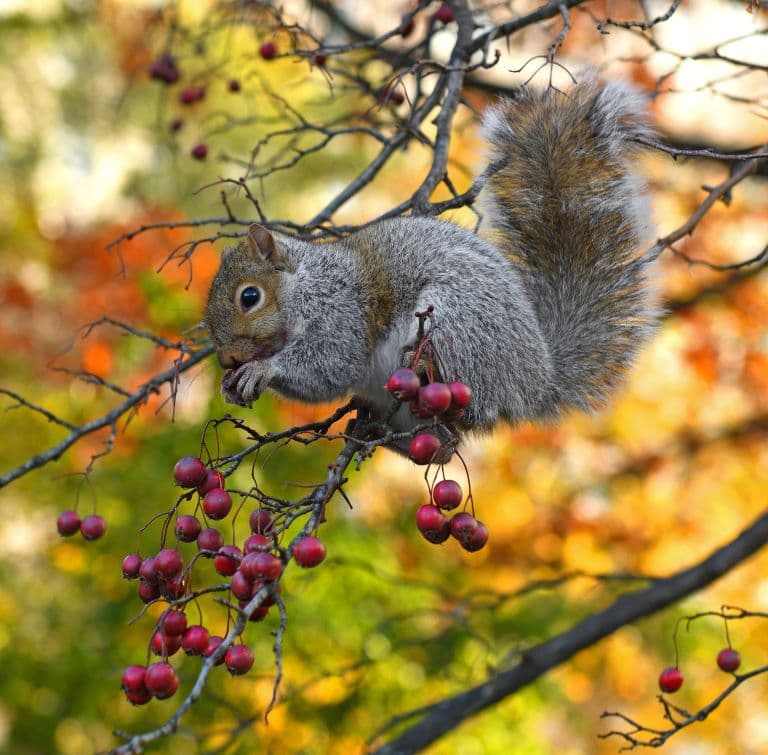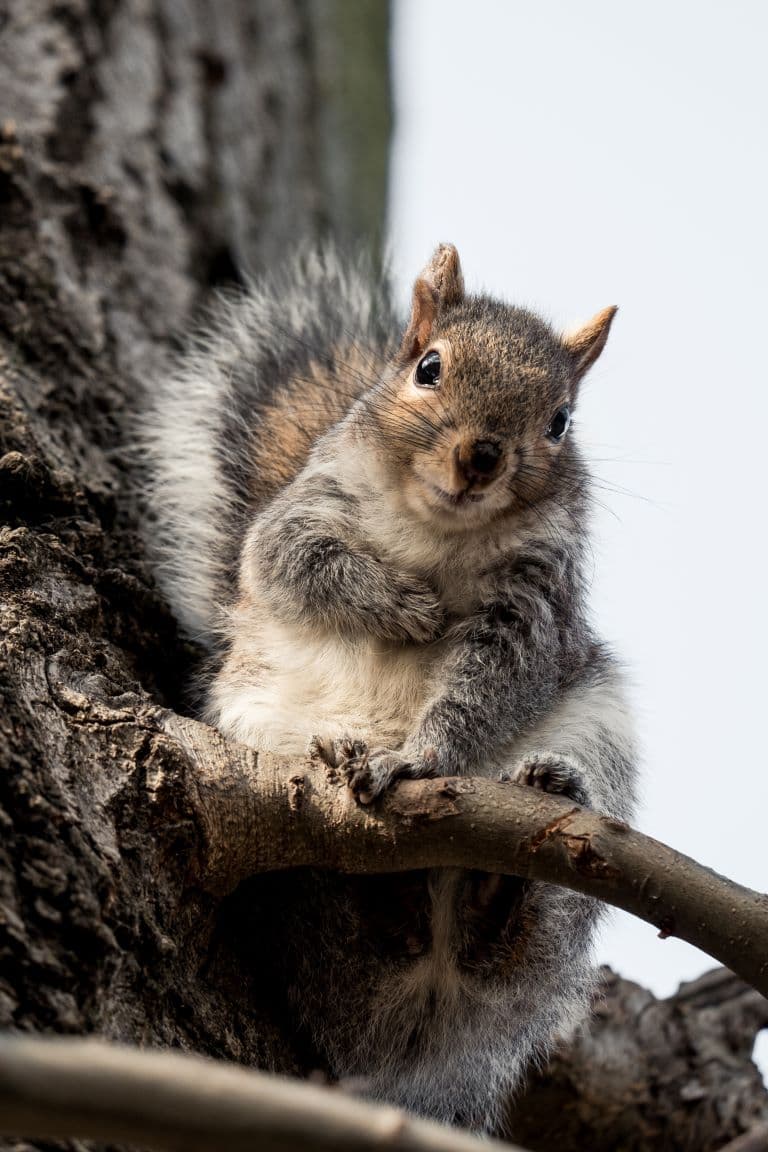Eastern Gray Squirrel Profile
The Sciuridae family contains all the squirrels, from so-called flying squirrels to the chunky marmots and tiny chipmunks.
In Europe, the most dominant species is the red tree squirrel, found in more or less every country on the continent.
As is the trend, the US is home to the far larger relatives of the European mammals, and for squirrels everywhere East of the Mississippi River, this species is the Eastern grey (or Gray, since it’s an American species) squirrel.
Divided by the Atlantic, the two species should never have met, but an introduced population has wreaked havoc on the red squirrel distribution in the UK, and perhaps threatens the species on the mainland, too.

Eastern Gray Squirrel Facts Overview
| Habitat: | Hardwood or mixed forests, as well as in urban and suburban areas |
| Location: | Eastern North America, introduced to UK, Italy |
| Lifespan: | Around 12 in the wild, up to 24 in captivity. |
| Size: | 23 to 30 cm (9.1 to 11.8 in) in body length, tail up to 25 cm (9.8 in) |
| Weight: | 400 to 750 g (14 to 26 oz). |
| Colour: | Grey, sometimes white or black |
| Diet: | Tree bark, tree buds, flowers, berries, many types of seeds and acorns, walnuts, and other nuts, insects, frogs, eggs, bone |
| Predators: | Most mesopredators: coyotes, raptors, cats, dogs, mustelids, snakes, etc |
| Top Speed: | Unknown |
| No. of Species: | 1 |
| Conservation Status: | Least Concern (IUCN) |
Grey squirrels, like all rodents, are objectively adorable and anyone who suggests otherwise is mistaken.
These large tree squirrels are important as both predators and prey in their native lands, but their large size and intelligent nature have caused a lot of problems for the natives of the regions where they have been introduced.
Unfortunately, they are a truly destructive force in the UK, and despite being cute, will need to be massacred if the native red squirrel is to be saved.
Interesting Eastern Gray Squirrel Facts
1. They’re close cousins of the Eurasian Red
North America actually has its own red squirrel, an even smaller animal than the Eurasian red, called Tamiasciurus hudsonicus. But these are less related to the Eastern grey than the Eurasian red is, as the latter two are members of the Sciurius genus.
Sciurus is an adaptable and widespread squirrel genus, the most diverse of the squirrel family with around 28 species, and spans most of the Americas, Europe and Asia, though the vast majority of species (at least 25) are native to the New World.
These squirrels are characterised by their big, bushy tails that can often be seen hanging over their backs.
They range in size from around 175g to about 750g, which places the Eastern Gray near the top of the scale at an average mass of around 550g, and a maximum of 750 g, though the fox squirrel, Sciurus niger, more commonly reaches this weight. 1
2. They’re not all grey
Eastern greys come in a variety of colours. The most common is the colour it gets its name from, but they’re also often seen sporting brown, reddish and creamy coats.
To complicate things a little, the Western grey squirrel’s Latin name is Sciurus gresius, meaning “Grey squirrel”, and this little fella is remarkably similar in appearance and diversity of fur colours.
Both also come in striking melanistic and leucitic models, and both look a lot like the larger Fox squirrel.
But Eastern greys are bolder and spend more time on the ground than their Western counterparts. They’re also found, as the name suggests, in the East and are not native to the West any further than the banks of the Mississippi. 2

3. They’re killers
Squirrels are rodents, and rodents are cute. It’s just a thing they’ve got, and they know it. But squirrels are some of the most cute: sitting up there with their little hands, gnawing on a nut, periodically pausing to try to remember the name of something, and then returning to their work.
But this cuteness is a bit of a façade because these cheeky little mammals are also quite formidable predators.
While they’re known for their keenness of strawberries, wheat and acorns, they’re also commonly seen raiding bird nests for eggs, and if the eggs have hatched, the helpless chicks themselves.
Squirrels are omnivores and will eat insects, birds, frogs, other rodents, and bits of bone or antlers too. 3
4. They’re acrobats
When they’re not out on the kill (and even when they are), these large squirrels can be seen exploiting some incredible evolutionary adaptations that make them adept in the arboreal world.
The Eastern grey is a rare mammal in its ability to climb head-first down a tree trunk. Part of this skill comes from its ability to rotate its hind foot 180 degrees, allowing it extra grip when upside-down.
They’re even more agile going up and along branches and can jump between trees with ease.
5. They’re seed dispersers
Like many squirrels, this one hoards nuts. And it does so in a strategy known as scatter-hoarding, in which little holes are dug all over the place and seeds are placed inside for safekeeping.
Interestingly, the squirrel is a crafty little rodent and has been witnessed pretending to bury its seeds while watched by something that might want to steal them.
This decoy is effective to the point where even the squirrel sometimes forgets where it put the seeds, and they promptly germinate and turn into trees.

6. They’re disease vectors
Plague is commonly thought to be a thing of the past, but this is just one of many misconceptions around the disease.
It was once thought to be spread by rats, and while rats probably didn’t have the best reputation before that, they have certainly suffered since.
This turned out to be an entirely false accusation, as it was, in fact, fleas that spread the plague virus, and recent research suggests it wasn’t even the fleas on rats, but the fleas on humans that were responsible.
Squirrels, on the other hand, are thought to be plague vectors, and they also carry typhus and tularaemia, caused by a friendly little bacterium that forms ulcers and other lovely stuff.
A plague-infected squirrel shut down a California school in 2013, which is quite an impressive feat considering how small their hands are and how tired plague can make you. 4
7. They’re invasive
Bankers have done a lot of irreparable damage to the UK over the years.
Exactly a decade after the collapse of the London wholesale bank Overend, Gurney & Company caused the great Panic of 1866, a banker by the name of Thomas Brocklehurst decided it’d be a great idea to release a bunch of grey squirrels into the wild, starting a trend that would result in the collapse of the Red squirrel across most of the country.
Some estimate the financial effect of their damage to the forests at around £50 million a year, and it’s no secret that the once prevalent red squirrel has been chased into the colder Northern regions and now is mostly only found in Scotland.
These adorable, disease-ridden bird-killing cuties are a major threat amid an orchestra of major threats to British wildlife and ultimately will need to be culled to protect the islands’ ecosystems.

Eastern Gray Squirrel Fact-File Summary
Scientific Classification
| Kingdom: | Animalia |
| Phylum: | Chordata |
| Class: | Mammalia |
| Order: | Rodentia |
| Family: | Sciuridae |
| Genus: | Sciurus |
| Species Name: | carolinensis |
Fact Sources & References
- (2019), “The Most Common Squirrel Species in the U.S.”, Shumaker’s Animal Control.
- “Sciurus tree squirrels”, Animal Diversity Web.
- Monique Warner, “Are Squirrels Omnivores, Herbivores or Carnivores?”, Misfit Animals.
- Eric Levenson (2013), “How Worried Should We Be About Squirrels Carrying the Bubonic Plague?”, The Atlantic.
